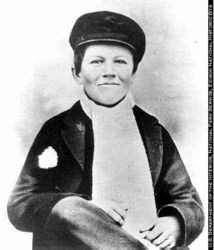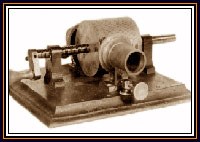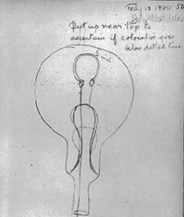
NPS Photo Thomas Alva Edison was born on February 11, 1847 in Milan, Ohio; the seventh and last child of Samuel and Nancy Edison. When Edison was seven his family moved to Port Huron, Michigan. Edison lived here until he struck out on his own at the age of sixteen. Edison had very little formal education as a child, attending school only for a few months. He was taught reading, writing, and arithmetic by his mother, but was always a very curious child and taught himself much by reading on his own. This belief in self-improvement remained throughout his life. Edison began working at an early age, as most boys did at the time. At thirteen he took a job as a newsboy, selling newspapers and candy on the local railroad that ran through Port Huron to Detroit. He seems to have spent much of his free time reading scientific, and technical books, and also had the opportunity at this time to learn how to operate a telegraph. By the time he was sixteen, Edison was proficient enough to work as a telegrapher full time. The development of the telegraph was the first step in the communication revolution, and the telegraph industry expanded rapidly in the second half of the 19th century. This rapid growth gave Edison and others like him a chance to travel, see the country, and gain experience. Edison worked in a number of cities throughout the United States before arriving in Boston in 1868. Here Edison began to change his profession from telegrapher to inventor. He received his first patent on an electric vote recorder, a device intended for use by elected bodies such as Congress to speed the voting process. This invention was a commercial failure. Edison resolved that in the future he would only invent things that he was certain the public would want. Edison moved to New York City in 1869. He continued to work on inventions related to the telegraph, and developed his first successful invention, an improved stock ticker called the "Universal Stock Printer". For this and some related inventions Edison was paid $40,000. This gave Edison the money he needed to set up his first small laboratory and manufacturing facility in Newark, New Jersey in 1871. During the next five years, Edison worked in Newark inventing and manufacturing devices that greatly improved the speed and efficiency of the telegraph. He also found to time to get married to Mary Stilwell and start a family. In 1876 Edison sold all his Newark manufacturing concerns and moved his family and staff of assistants to the small village of Menlo Park, twenty-five miles southwest of New York City. Edison established a new facility containing all the equipment necessary to work on any invention. This research and development laboratory was the first of its kind anywhere; the model for later, modern facilities such as Bell Laboratories, this is sometimes considered to be Edison's greatest invention. Here Edison began to change the world. 
NPS Photo The first great invention developed by Edison in Menlo Park was the tin foil phonograph. The first machine that could record and reproduce sound created a sensation and brought Edison international fame. Edison toured the country with the tin foil phonograph, and was invited to the White House to demonstrate it to President Rutherford B. Hayes in April 1878. Edison next undertook his greatest challenge, the development of a practical incandescent, electric light. The idea of electric lighting was not new, and a number of people had worked on, and even developed forms of electric lighting. But up to that time, nothing had been developed that was remotely practical for home use. Edison's eventual achievement was inventing not just an incandescent electric light, but also an electric lighting system that contained all the elements necessary to make the incandescent light practical, safe, and economical. After one and a half years of work, success was achieved when an incandescent lamp with a filament of carbonized sewing thread burned for thirteen and a half hours. The first public demonstration of the Edison's incandescent lighting system was in December 1879, when the Menlo Park laboratory complex was electrically lighted. Edison spent the next several years creating the electric industry. In September 1882, the first commercial power station, located on Pearl Street in lower Manhattan, went into operation providing light and power to customers in a one square mile area; the electric age had begun. 
NPS Photo The success of his electric light brought Edison to new heights of fame and wealth, as electricity spread around the world. Edison's various electric companies continued to grow until in 1889 they were brought together to form Edison General Electric. Despite the use of Edison in the company title however, Edison never controlled this company. The tremendous amount of capital needed to develop the incandescent lighting industry had necessitated the involvement of investment bankers such as J.P. Morgan. When Edison General Electric merged with its leading competitor Thompson-Houston in 1892, Edison was dropped from the name, and the company became simply General Electric. This period of success was marred by the death of Edison's wife Mary in 1884. Edison's involvement in the business end of the electric industry had caused Edison to spend less time in Menlo Park. After Mary's death, Edison was there even less, living instead in New York City with his three children. A year later, while vacationing at a friends house in New England, Edison met Mina Miller and fell in love. The couple was married in February 1886 and moved to West Orange, New Jersey where Edison had purchased an estate, Glenmont, for his bride. Thomas Edison lived here with Mina until his death. When Edison moved to West Orange, he was doing experimental work in makeshift facilities in his electric lamp factory in nearby Harrison, New Jersey. A few months after his marriage, however, Edison decided to build a new laboratory in West Orange itself, less than a mile from his home. Edison possessed both the resources and experience by this time to build, "the best equipped and largest laboratory extant and the facilities superior to any other for rapid and cheap development of an invention ". The new laboratory complex consisting of five buildings opened in November 1887. A three story main laboratory building contained a power plant, machine shops, stock rooms, experimental rooms and a large library. Four smaller one story buildings built perpendicular to the main building contained a physics lab, chemistry lab, metallurgy lab, pattern shop, and chemical storage. The large size of the laboratory not only allowed Edison to work on any sort of project, but also allowed him to work on as many as ten or twenty projects at once. Facilities were added to the laboratory or modified to meet Edison's changing needs as he continued to work in this complex until his death in 1931. Over the years, factories to manufacture Edison inventions were built around the laboratory. The entire laboratory and factory complex eventually covered more than twenty acres and employed 10,000 people at its peak during World War One (1914-1918). After opening the new laboratory, Edison began to work on the phonograph again, having set the project aside to develop the electric light in the late 1870s. By the 1890s, Edison began to manufacture phonographs for both home, and business use. Like the electric light, Edison developed everything needed to have a phonograph work, including records to play, equipment to record the records, and equipment to manufacture the records and the machines. In the process of making the phonograph practical, Edison created the recording industry. The development and improvement of the phonograph was an ongoing project, continuing almost until Edison's death. While working on the phonograph, Edison began working on a device that, "does for the eye what the phonograph does for the ear", this was to become motion pictures. Edison first demonstrated motion pictures in 1891, and began commercial production of "movies" two years later in a peculiar looking structure, built on the laboratory grounds, known as the Black Maria. Like the electric light and phonograph before it, Edison developed a complete system, developing everything needed to both film and show motion pictures. Edison's initial work in motion pictures was pioneering and original. However, many people became interested in this third new industry Edison created, and worked to further improve on Edison's early motion picture work. There were therefore many contributors to the swift development of motion pictures beyond the early work of Edison. By the late 1890s, a thriving new industry was firmly established, and by 1918 the industry had become so competitive that Edison got out of the movie business all together. The success of the phonograph and motion pictures in the 1890s helped offset the greatest failure of Edison's career. Throughout the decade Edison worked in his laboratory and in the old iron mines of northwestern New Jersey to develop methods of mining iron ore to feed the insatiable demand of the Pennsylvania steel mills. To finance this work, Edison sold all his stock in General Electric. Despite ten years of work and millions of dollars spent on research and development, Edison was never able to make the process commercially practical, and lost all the money he had invested. This would have meant financial ruin had not Edison continued to develop the phonograph and motion pictures at the same time. As it was, Edison entered the new century still financially secure and ready to take on another challenge. Edison's new challenge was to develop a better storage battery for use in electric vehicles. Edison very much enjoyed automobiles and owned a number of different types during his life, powered by gasoline, electricity, and steam. Edison thought that electric propulsion was clearly the best method of powering cars, but realized that conventional lead-acid storage batteries were inadequate for the job. Edison began to develop an alkaline battery in 1899. It proved to be Edison's most difficult project, taking ten years to develop a practical alkaline battery. By the time Edison introduced his new alkaline battery, the gasoline powered car had so improved that electric vehicles were becoming increasingly less common, being used mainly as delivery vehicles in cities. However, the Edison alkaline battery proved useful for lighting railway cars and signals, maritime buoys, and miners lamps. Unlike iron ore mining, the heavy investment Edison made over ten years was repaid handsomely, and the storage battery eventually became Edison's most profitable product. Further, Edison's work paved the way for the modern alkaline battery. By 1911, Thomas Edison had built a vast industrial operation in West Orange. Numerous factories had been built through the years around the original laboratory, and the staff of the entire complex had grown into the thousands. To better manage operations, Edison brought all the companies he had started to make his inventions together into one corporation, Thomas A. Edison Incorporated, with Edison as president and chairman. Edison was sixty-four by this time and his role with his company and in life began to change. Edison left more of the daily operations of both the laboratory and the factories to others. The laboratory itself did less original experimental work and instead worked more on refining existing Edison products such as the phonograph. Although Edison continued to file for and receive patents for new inventions, the days of developing new products that changed lives and created industries were behind him. In the 1915, Edison was asked to head the Naval Consulting Board. With the United States inching closer towards the involvement in World War One, the Naval Consulting Board was an attempt to organize the talents of the leading scientists and inventors in the United States for the benefit of the American armed forces. Edison favored preparedness, and accepted the appointment. The Board did not make a notable contribution to the final allied victory, but did serve as a precedent for future successful cooperation between scientists, inventors and the United States military. During the war, at age seventy, Edison spent several months on Long Island Sound in a borrowed navy vessel experimenting on techniques for detecting submarines. Edison's role in life began to change from inventor and industrialist to cultural icon, a symbol of American ingenuity, and a real life Horatio Alger story. In 1928, in recognition of a lifetime of achievement, the United States Congress voted Edison a special Medal of Honor. In 1929 the nation celebrated the golden jubilee of the incandescent light. The celebration culminated at a banquet honoring Edison given by Henry Ford at Greenfield Village, Ford's new American history museum, which included a complete restoration of the Menlo Park Laboratory. Attendees included President Herbert Hoover and many of the leading American scientists and inventors. The last experimental work of Edison's life was done at the request of Edison's good friends Henry Ford, and Harvey Firestone in the late 1920s. They asked Edison to find an alternative source of rubber for use in automobile tires. The natural rubber used for tires up to that time came from the rubber tree, which does not grow in the United States. Crude rubber had to be imported and was becoming increasingly expensive. With his customary energy and thoroughness, Edison tested thousands of different plants to find a suitable substitute, eventually finding a type of Goldenrod weed that could produce enough rubber to be feasible. Edison was still working on this at the time of his death. During the last two years of his life Edison was in increasingly poor health. Edison spent more time away from the laboratory, working instead at Glenmont. Trips to the family vacation home in Fort Myers, Florida became longer. Edison was past eighty and suffering from a number of ailments. In August 1931 Edison collapsed at Glenmont. Essentially house bound from that point, Edison steadily declined until at 3:21 am on October 18, 1931 the great man died. |
Last updated: February 26, 2015
